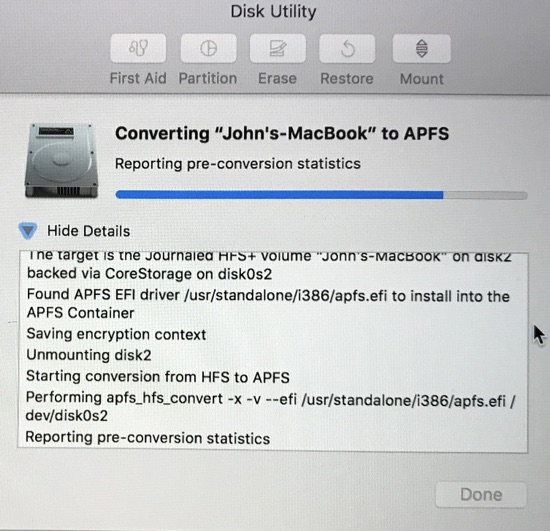Sep 06, 2017 I understand Apple will provide a set of instructions with the GM Release to guide APFS Users to convert back to HFS+. I have been running an APFS version of Beta releases of High Sierra since day one on my iMac (Retina 5K, 27-inch, Late 2014, 16GB) 1TB Fusion Drive APFS looks pretty solid, except for a failure to properly Wake from Sleep. Jun 17, 2017 Are there any formats I could convert to (after backup and with large file sizes) FIRST that would then allow me to then convert to HFS or APFS without data loss? Or is my only legitimate option to offload the data and convert with a complete wipe of those drives? Select the drive (left side window pane) and select the “Convert to APFS” option from the drop-down list. If option is not available or greyed out then please read this article.
The problem is, unlick High Sierra, the command used to avoid APFS conversion, –converttoapfs isn’t a recognized option in startosinstallAnd therefore, in order to avoid APFS conversion, you need to find out an alternative way. Through a little research and common sense, I was able to install macOS Mojave on an HFS+ drive and prevented APFS conversion on my SSD. Interestingly, there are two distinct different ways to install macOS Mojave without APFS conversion and we have discussed each with step by step instruction and screenshots. Video guide will be uploaded soon.Apple Mac users can also use these methods to avoid APFS conversion and install macOS Mojave 10.14 on HFS+ (macOS Journaled Partition). Method 1: During macOS Mojave InstallationBoth Apple users and Hackintosh users can use this method to prevent APFS conversion during macOS Mojave 10.14 installation. It’s easy and doesn’t take much time. However, you need to create a macOS installer media.
Upgrading directly from macOS installer downloaded from App Store is not possible.So visit this post and create a macOS Mojave installer media. If you face any issue, comment down below and we will get back to you ASAP with the right solution. Method 2: After macOS Mojave InstallationThis is one of the easiest but messy process, which required an external drive (SSD or HDD).
In this method, you will be installing macOS Mojave 10.14 normally using USB installer with APFS file system but on the external hard drive or SSD. You can read this post on How to install macOS on external drive for more details. After installing Mojave, follow these instructions. Boot macOS Mojave from the external drive. After initial setup and login, download and install Carbon Copy Cloner app. Open Disk Utility and select the internal drive. Click Erase.
Enter the name you wish to give, choose macOS journaled and click ‘Erase’. Run Carbon Copy Cloner app. Choose Source drive as your external Disk and Destination your internal drive. Click start cloning. Wait for a while until the software finished cloning processNow disconnect external drive and reboot system normally.

Go to About MacSystem information and check the file system of your internal drive. You can also use Disk Utility to check the File System that must be HFS+.So that’s how you avoid APFS conversion of your SSD, fusion drives, hybrid drives, and hard drive during and after macOS Mojave installation.I hope this post was helpful, please share and subscribe for more such exclusive how to guides. You can also subscribe us on YouTube for video guides if reading is something you don’t prefer.
External Drive Apfs
While Windows dominates the desktop market, Macs are still widely used, especially in smaller organizations. Knowing how to administer and configure macOS is a key skill that any IT admin should know. In this course, Sean Colins looks at Mac's latest operating system—Sierra—focusing on the most important topics for administrators. You'll first dive into backing up and restoring Sierra, using the built-in solution, Time Machine, and a cloud-based alternative, Backblaze.
You'll then learn about iCloud administration, including techniques for restoring deleted files from iCloud and disabling iCloud entirely. Next, learn about working with local storage and the new Apple File System (APFS), which—once released—will provide a unified storage solution across macOS, iOS, tvOS, and watchOS. Then find out how to monitor macOS Sierra using the new console, unified logging system, and commands for collecting, searching, and debugging logs. The course then concludes with an overview of enterprise-wide security solutions for Sierra and how mobile device management can help with system imaging at scale.
You can read that on the mod descriptions. Add stability on top of that, and I have just never looked back.Now that SKSE64 is out, a lot of mod authors are porting their mods to SSE and quite a few mod authors will longer support the LE version of their mods because it's too much work to support two different formats. There are over FOURTEEN THOUSAND mods for Skyrim SE. Skyrim se vs skyrim mods. Yeah, you can mod LE to look pretty awesome, but SSE is awesome right out of the box, and with a few mods here and a few mods there, it's downright gorgeous. My vote is for SSE.